LU breaks ground on new Science and Technology Building
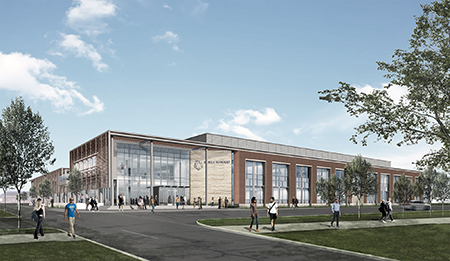 Lamar University administrators, Texas State University System representatives, retired and current staff and faculty members and alumni gathered today (May 2, 2017) to break ground for the construction of a new 83,000-square-foot Science and Technology Building.
Lamar University administrators, Texas State University System representatives, retired and current staff and faculty members and alumni gathered today (May 2, 2017) to break ground for the construction of a new 83,000-square-foot Science and Technology Building.
Work clearing the construction site is scheduled to begin May 8 with substantial completion expected in late November 2018. The building is the design of architect Gensler working with a faculty-led university committee, and will be built by Vaughn Construction, becoming the first new entirely academic building to be added to the LU campus in more than four decades.
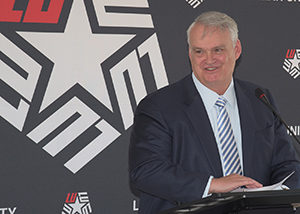 “This building is long overdue, and the [Texas State University] System is very happy to facilitate that,” said TSUS Regent Bill Scott in addressing the crowd assembled on the future construction site. “This 83,131 square-foot science and technology building will make this university, the system, and all of Southeast Texas very proud.”
“This building is long overdue, and the [Texas State University] System is very happy to facilitate that,” said TSUS Regent Bill Scott in addressing the crowd assembled on the future construction site. “This 83,131 square-foot science and technology building will make this university, the system, and all of Southeast Texas very proud.”
The new Science and Technology building is sited to take advantage of a future pedestrian corridor planned for Cunningham Street and new campus entry off Rolfe Christopher Drive. The site is a prominent location and will be a highly visible as Lamar University continues to grow.
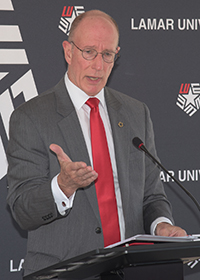 “It’s a great building and we’re really excited about what this is going to mean,” said LU President Ken Evans. “It’s interesting, we celebrate buildings— and that’s great, and they’re an important part of a transformational activity on a campus— but they’re really only a tool.”
“It’s a great building and we’re really excited about what this is going to mean,” said LU President Ken Evans. “It’s interesting, we celebrate buildings— and that’s great, and they’re an important part of a transformational activity on a campus— but they’re really only a tool.”
“As much as we celebrate the building, it’s an opportunity for us to recruit better students, to recruit better faculty, to, in turn, transform our programs, and to be more competitive in the marketplace,” Evans said.
“At the end of the day, it’s where science and technology takes us in terms of evolving our economy and our ability to solve problems so vital to the global landscape,” Evans said.
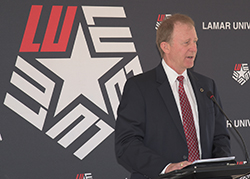 “Today signifies in a tangible – bricks and mortar – way the significant changes that are already taking place in pedagogy and student learning experiences across the campus,” said James Marquart, provost and vice president for academic affairs. “Today, academe reflects – and in many instances leads – in a new paradigm that reflects the rapid pace of technology and the increasingly interconnectedness of our world.”
“Today signifies in a tangible – bricks and mortar – way the significant changes that are already taking place in pedagogy and student learning experiences across the campus,” said James Marquart, provost and vice president for academic affairs. “Today, academe reflects – and in many instances leads – in a new paradigm that reflects the rapid pace of technology and the increasingly interconnectedness of our world.”
“Research and instruction must be cross-disciplinary,” Marquart said. “We must bring together the best and brightest minds at all levels whatever their academic discipline to address big challenges through cooperation and innovation. This thinking informed the design of the building thanks to the hard work of a faculty-led committee.”
“I believe this building will have a profound affect on Lamar University’s strategic plan to grow a stronger faculty that, in turn, benefits student,” Marquart added. “Here, cooperative multi-disciplinary discovery will become the norm and generations of graduates will go from here ready to impact their world with a wider vision of what science and technology can do to serve mankind and solve real world problems.”
 Ashwini Kucknoor, associate professor of biology, called the building “an investment in the young people who will become the next generation of scientist and scholars. If universities like Lamar are to continue to conduct the vital research that transforms our world and enhances our lives, then faculty and students must have the facilities and the space to support learning and research. The Science and Technology Building is such a facility that has been designed to foster collaboration. Shared research and lab space will provide us opportunities to work together on cutting-edge projects. Collaboration is at the heart of discovery.”
Ashwini Kucknoor, associate professor of biology, called the building “an investment in the young people who will become the next generation of scientist and scholars. If universities like Lamar are to continue to conduct the vital research that transforms our world and enhances our lives, then faculty and students must have the facilities and the space to support learning and research. The Science and Technology Building is such a facility that has been designed to foster collaboration. Shared research and lab space will provide us opportunities to work together on cutting-edge projects. Collaboration is at the heart of discovery.”
Faculty Senate President Sarah Tusa, Student Government Association President Aaron Lavergne, Regent Scott, President Evans, and Provost Marquart joined in turning dirt symbolically beginning the project.
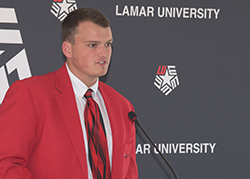 Cade Johnson, a senior double major in biology and exercise science and fitness management from Lumberton, brought a student perspective to the occasion by sharing about the impact of faculty mentors on his academic development while an undergraduate at LU.
Cade Johnson, a senior double major in biology and exercise science and fitness management from Lumberton, brought a student perspective to the occasion by sharing about the impact of faculty mentors on his academic development while an undergraduate at LU.
Once the new Science and Technology Building is completed, many of the activities now taking place in the Hayes Biology Building will move, but that venerable building will remain an active and vital part of science education on campus. The new building will enhance science education and build on the legacy of teaching and student engagement at LU.
As a platform for research creativity, this new facility will embody a new paradigm for interaction, instruction, and research at the University. Allotting over three-fourths of assignable square footage to instructional laboratories for upper-level biology, interdisciplinary flex research laboratories, and an innovation space, the new facility will allow the University to better serve students and faculty across all science disciplines and form strategic partnerships for various research initiatives.
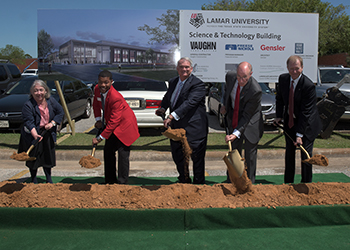 Upper level biology instruction will focus on experimental methods, systematics and technology, cell/molecular biology, organisms, and botany. An exterior greenhouse is included in the project for additional instructional purposes. Flexible research labs will serve organic/wet chemistry, cell/molecular biology, biochemistry, computation, and engineering. The innovation space will provide necessary capabilities to build and prototype special design and interdisciplinary research projects focused on energy, sustainability, medical devices, and global health at the undergraduate and graduate level.
Upper level biology instruction will focus on experimental methods, systematics and technology, cell/molecular biology, organisms, and botany. An exterior greenhouse is included in the project for additional instructional purposes. Flexible research labs will serve organic/wet chemistry, cell/molecular biology, biochemistry, computation, and engineering. The innovation space will provide necessary capabilities to build and prototype special design and interdisciplinary research projects focused on energy, sustainability, medical devices, and global health at the undergraduate and graduate level.
The new Science and Technology building will also include a multipurpose space, faculty offices, a senior leadership suite, and required building support spaces. These spaces will support the University’s growing demand for science instruction and research, reflect a high level of quality instruction, and ensure faculty presence within the new facility.
An upgrade and expansion to the South Central Plant, already begun, will provide chilled water and electrical service to the new building as well as additional capacity for future campus growth.


